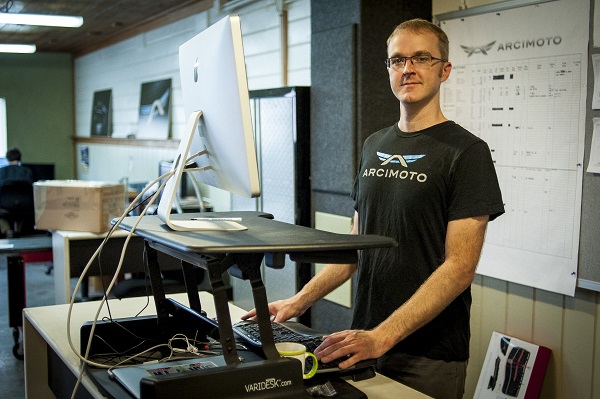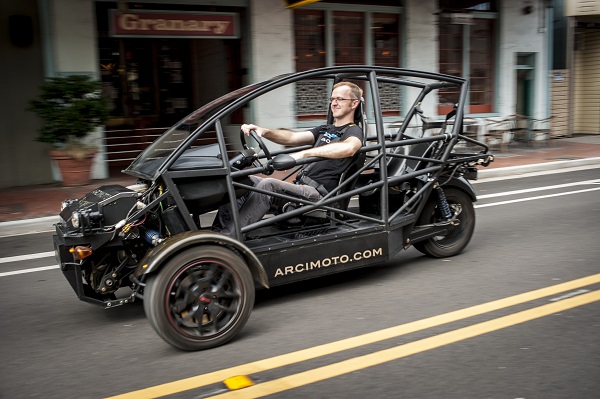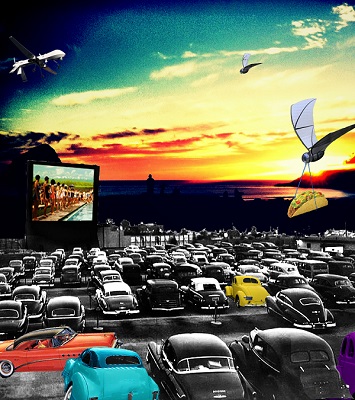
photo by Jon C. Meyers
Mark Frohnmayer always loved driving, but the pleasure came with a cost—the guilt of burning fossil fuels. In 2007, he founded Arcimoto with the goal of creating a three-wheeled electric vehicle with a smug factor as impressive as its fun factor. The Eugene-based company will roll out its pilot fleet this year.
Arcimoto’s nimble, lightweight baby, called SRK—short for Simple, Reliable, Kick-ass—has a 100-horsepower electric motor, trellis frame construction, tandem seating and multiple charging options. The vehicle can travel up to 120 miles per charge and tops out at seventy-five miles per hour. Frohnmayer calls it the ninety percent solution. “It fits the typical driving pattern, which is to use the vehicle for short trips,” he said.
Though the SRK is conceptually more motorcycle than car, operating one doesn’t require a helmet or special license, and it drives like an automatic car. Its appearance—half Volkswagen, half dune-buggy—distinguishes it from other electric vehicles. The in-line configuration seats two, plus cargo, and its low-slung cockpit drops the center of gravity to improve handling. Its body panels are removable much like a Jeep and a convertible. “When you pull up to a stop sign it’s totally silent,” added Frohnmayer, 40.
 photo by Jon C. Meyers
photo by Jon C. Meyers
Arcimoto, a combination of concepts, means “Future I Drive,” was born when Frohnmayer started looking for a viable sustainable transportation option, modeled on the bicycle. Born and raised in Eugene, Frohnmayer lived car-free for years, but was on the lookout for a guilt-free ride for trips across town. He found a DIY kit for the BugE, a battery-powered three-wheeler akin to a scooter. Frohnmayer then ordered one to study it. BugE’s “super-minimalist vehicle” didn’t have the speed, range or ability to carry more than one passenger, but it did have the ability to spark Frohnmayer’s imagination.
Inspired to develop planet-saving technology without sacrificing “tactile fun,” he sold his gaming business—another trail-blazing startup, called GarageGames—to provide seed funding for Arcimoto. Since then, the company has scored more than $1 million in funding, including a $50,000 grant from Drive Oregon, a nonprofit dedicated to supporting and expanding electric mobility in the state. He recruited Joe Morgan, who had years of experience in motorcoach manufacturing, and applied his same iterative process for developing video games to his electric vehicle.
 photo by Jon C. Meyers
photo by Jon C. Meyers
Arcimoto’s prototype was an open-air vehicle not unlike the kit he had ordered. Gen 3, the Pulse, solidified some of the vehicle’s defining characteristics, including tandem seating and basic footprint. Subsequent generations focused on improving the drive train and ergonomics, lowering the center of gravity, introducing front-wheel drive and incorporating lithium battery technology.
The battery bay is modular, to better accommodate advances in battery technology. For now, Arcimoto plans to offer three battery options, with ranges of 40, 80 and 120 miles. Because it’s intended as an everyday vehicle that can be charged at night in a common household electrical outlet, the SRK does not depend on a comprehensive charging network—a deliberate decision, said Frohnmayer.
“There’s a whole segment of people who understand what’s happening with climate, and they’re hungry for a more reasonable solution,” he said. The upstart company is in the process of recruiting early adopters for its pilot fleet of fifteen vehicles. First in line is actor Nathan Fillion, best known for his lead role in the ABC series “Castle.” Fillion has been an enthusiastic spokesperson for the company since he and costar Jon Huertas test-drove the Pulse several years ago.
 photo by Jon C. Meyers
photo by Jon C. Meyers
“It’s addressing a couple of problems,” Fillion told talk show host Conan O’Brien, while he was a guest on O’Brien’s show last year. “One is resources—you’re not building an enormous car to just drive one person to work—plus it’s electric, which I think is a no-brainer by now.” Fillion’s SRK should be ready to roll in October.
Frohnmayer’s vision of the future includes fleets of driverless electric vehicles—think Google’s driverless car—running on existing infrastructure and complemented by public mass transportation. Though Arcimoto does not have its own manufacturing facility, many of the components are made locally, drawing on Lane County’s pool of skilled labor. “Oregon is a great place to grow a company,” he said. “There are lots of talented people and early pioneers in the EV industry here.”









